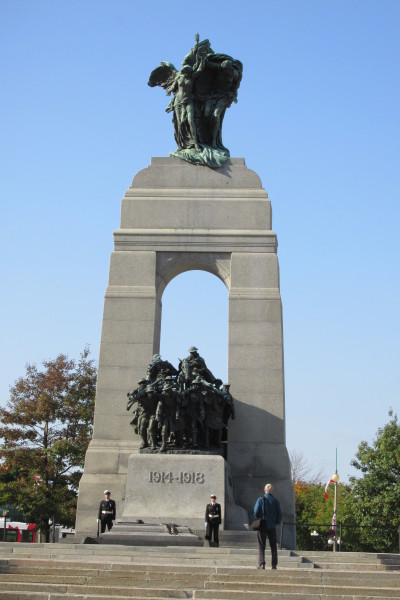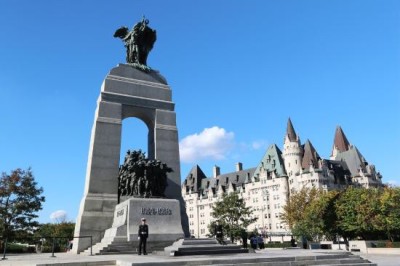The National War Memorial, also known as “The Response,” is a cenotaph symbolizing the sacrifice of all Canadian Armed Forces personnel who have served Canada in time of war in the cause of peace and freedom--past, present and future. The memorial is the site of the national Remembrance Day Ceremony on November 11.
The National War Memorial was first unveiled in 1939 to commemorate the response of Canadians in the First World War 1914-1918. Over the years, the memorial has come to symbolize the sacrifice of all Canadians who have served Canada in time of war and was rededicated to their honour.
World-wide competition (1925)
After the First World War, 1914-1918, there was a strong feeling in Canada that a memorial should be built to recognize those who had served their country in that war.
In 1925, a world-wide competition was held to choose a design for a national commemorative war monument to be built in the capital of Canada. It was to be "expressive of the feelings of the Canadian people as a whole, to the memory of those who participated in the Great War and lost their lives in the service of humanity." The competition regulations also stated that the vision which the government wished to keep alive was "the spirit of heroism, the spirit of self-sacrifice, the spirit of all that is noble and great that was exemplified in the lives of those sacrificed in the Great War, and the services rendered by the men and women who went overseas.”
The competition was open to architects, sculptors and artists residing in the British Empire, or who were British subjects by birth but residing elsewhere, or subject of Allied nations. A total of 127 entries were received - 66 from Canada, 24 from England, 21 from France, seven from the United States, five from Belgium, two from Italy, one from Scotland and one from Trinidad. Seven finalists were then chosen to submit scale models of their designs.
Winning entry (1926)
In January 1926, the Board of Assessors selected the model submitted by Vernon March of Farnborough, Kent, England. His theme was "the Great Response of Canada," represented by uniformed figures from all services passing through a granite arch. The idea, March wrote, was "to perpetuate in this bronze group the people of Canada who went Overseas to the Great War, and to represent them, as we of today saw them, as a record for future generations..." There was to be no suggestion of glorifying war.
Bronze figures (1932)
Vernon March was helped by his six brothers and his sister who completed the work after his untimely death in 1930. They molded the full size figures in clay, then cast them in plaster and finally made the bronze figures in their own foundry.
The figures were completed in July 1932, but it was not possible to commence construction of the memorial arch in Ottawa because the site was not yet ready. In 1933, the figures, mounted on a plaster-covered base were displayed in London's Hyde Park for six months. They were then stored in the Marchs’ studio until 1937 when they were shipped to Ottawa.
Granite pedestal and arch (1938)
In December 1937, a contract was awarded to E.G.M. Cape and Company, Montreal contractors, for the construction of the granite pedestal and arch. Work started the following year with Sydney March directing the construction. He was joined later by two of his brothers, Percy and Walter. On Wednesday, October 19, 1938, the memorial was completed, and placed on its permanent site in the Nation's Capital.
Official unveiling (1939)
After the completion of the memorial, only the work on the surrounding area was left. Jacques Greber, who had been chosen to make plans for the development of the city of Ottawa, was used as a consultant. A contract was awarded to A.W. Robertson Limited, Toronto contractors, for the terraces, walks and grading of the site for which seven varieties of Canadian granite were used. Everything was finished in time for the Royal visit in the spring of 1939.
The National War Memorial was officially unveiled by His Majesty King George VI on Sunday, May 21, 1939. In his address to an estimated 100,000 persons who gathered to witness the ceremony, King George spoke of the symbolism of the memorial and the sacrifice to which it was dedicated:
The memorial speaks to her world of Canada's heart. Its symbolism has been beautifully adapted to this great end. It has been well named "The Response." One sees at a glance the answer made by Canada when the world's peace was broken and freedom threatened in the fateful years of the Great War. It depicts the zeal with which this country entered the conflict.
Rededication (1982)
On May 29, 1982, the memorial was rededicated to include the dates of the Second World War 1939-1945 and the Korean War 1950-1953.
Tomb of the Unknown Soldier (2000)
In 2000, the Tomb of the Unknown Soldier was added in the front of the memorial. The tomb contains the remains of an unknown Canadian soldier from a war cemetery near Vimy Ridge, France.
Rededication (2014)
On November 11, 2014, the memorial was rededicated to include the dates of the South African War 1899-1902 and the mission in Afghanistan 2001-2014.
Photo: "War Memorial Guards Ottawa" by Jcart1534 - Own work. Licensed under Public domain via Wikimedia Commons - http://commons.wikimedia.org/wiki/File:War_Memorial_Guards_Ottawa.jpg#mediaviewer/File:War_Memorial_Guards_Ottawa.jpg





















